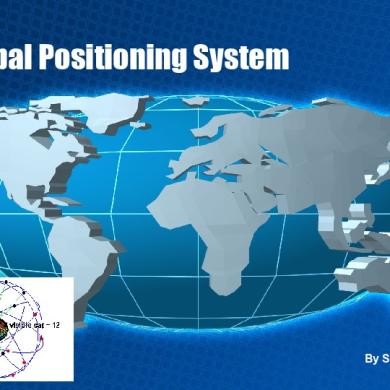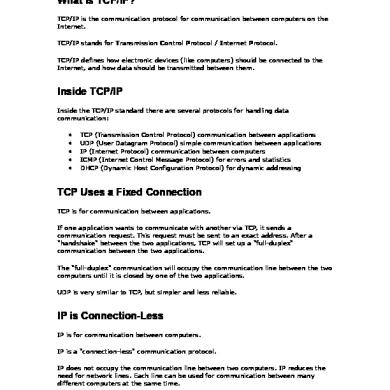Chapter 1 Intoduction
This document was uploaded by user and they confirmed that they have the permission to share it. If you are author or own the copyright of this book, please report to us by using this DMCA report form. Report DMCA
Overview
Download & View Chapter 1 Intoduction as PDF for free.
More details
- Words: 1,320
- Pages: 44
Chapter 1 Introduction
Major Contents Definition of Epidemiology Main Methods of Epidemiology Contributions of Epidemiology to the Medical Science
Section 1
Definition of Epidemiology
Definition Distinguish classical Epidemiology and clinical Epidemiology Branch of Epidemiology
Definition
:
Epidemiology is a discipline to study distribution (or occurrence and development) of diseases and health conditions in human populations and the factors influencing the distribution as well as to study the measures for the prevention and control of disease and promotion of health.
Three points: 1. Objects: human population,not individual
Classifying of medicine Elementary Medicine
Clinical Medicine Preventive Medicine
Study level
molecular or sub molecular Immunology Biochemistry; Cell biology individual patients Internal Medicine;surgery populations Epidemiology; Environmental Hygiene
2.Range and Content Range: infectious diseases, noninfectious
diseases, and health conditions
Content: distribution of diseases and health conditions; influencing factors
3.Aim Aim of Epidemiology is to prevent and control diseases, and to promote health.
Distinguish between classical Epidemiology and clinical Epidemiology
Classical Epidemiology:Study the community origins of health population,particularly those related to nutrition, the environment,human behavior,social, and spiritual state of a population.
Clinical Epidemiology is to use similar designs and statistical tools.However, their objects are patients, aim is to improve the diagnosis and treatment of diseases and the prognosis for patients.
For example: esophagus cancer Classical Epi: Epidemiologiests usually study a population of some cities or counties, survey the distribution of this cancer. At which time ,in which population, on which place, incidence rate is highest? Then, to study what reasons cause this result.
And then, according to those reasons,carrying out measures to decrease incidence rate or prevent the appearances of esophagus cancer.
Clinical Epi: Aims are how to improve the diagnosis method and find patients as soon as early, and to study which method is better or best to treat this disease, to estimate the patients’ prognosis, such as may he be dead quickly? May he be mended? How much time maybe he lives?
Branches of Epidemiology With the developing of Epi and other disciplines, more and more methods and theories of Epi are applied and produce some branches of Epi. Such as, Environmental Hygienic Epi; Labor Hygienic Epi; Occupational Epi.
If Epidemiology is applied to study some diseases,there are Tumer Epi; Vascular Disease Epi.
Section 2
Methods of Epidemiology Descriptive Study
Observational Methods Analysis Study Experimental Methods
Clinical Trial Field Trial Community Trial
1.Observational Methods Descriptive Study(Descriptive Epidemiology) Main job: to descript the distribution of diseases or health condition in different place, population and time. How can we get these datum? We can use methods as below:cross-sectional study or ecology study.
Main aim: to supply clues of cause of diseases. If we know the distribution of disease,we can know the incidence rate is more in which place,which population and which time. Then we survey or study the factor which exists more frequency in this population or place. Maybe, this factor is the risk factor of this disease.
For example: lung cancer At the begin,we don’t know the cause of lung cancer. Through descriptive study, we can know the characters of distribution of this disease. Population: incidence rate in male>female in older>younger
Place: consumption of tobacco is more,incidence rate is higher. Time: current year> before time Raise clue or hypotheses of cause: Smoking? True or not?
Analytic Study
Case-Control Study Aim: to test the hypotheses disease.
of cause of
Steps of case-control study: ① Selecting two groups of subjects: patients group (who have the interested disease) controls group ( without the disease)
② Surveying the exposures history which maybe have relationship with the disease using questionnaire. ③ Comparing the frequencies of exposure in two groups.
④ If group1> group 2 : draw a conclusion---there are relationship between the exposure and the disease. Pay attention to : not a cause-effect association.
Cohort Studies Aim:also to test the hypotheses ,moreover test cause-effect association, because the direction is prospective.
Steps of cohort study: ① Selecting two groups: exposure group (presence of exposure to a particular factor)
Non-exposure group (absence of factor)
② Following-up for a specified period time: In general,the follow-up period must be at least several years in order to allow for an adequate number to develop the outcome,so that meaningful comparisons can be made.
③ Comparing the incidence rates of researching disease between exposure group and non-exposure group. ④ If group 1 > group 2 , draw a conclusion: there is a cause-effect association between exposure and disease.
2.Experimental Study Experimental studies may be viewed as a type of prospective cohort study because participants are identified on the basis of their exposure status and followed to determine whether they develop the disease. The distinguishing feature of this study is that the exposure status of each participant is assigned by the investigator.
Steps of experimental studies: ① Selecting a number of objects and then divided them into two groups at random. Experimental group ( must be treated by one or more intervention factors)
Control group (
untreated or control factors)
②Following-up a certain period of time , and determined the incidence rates of disease of two groups. ③ Comparing the incidence rates of two groups. ④Judging the effect of interventions.
Three types: Study unite Clinical trial
Field trial
Aim
individuals of patients to estimate a kind of new drug or treatment method health individual who to estimate the effect of a has no interesting disease kind of vaccine
Community trial population
to estimate or judge a kind of prevention method
Section 3 Contributions of Epidemiology to the Medical Science
Investigating the Models of Transmission of A New Disease Determining Preventable Causes(or risk factors) of Disease Preventing and Controlling Diseases
1.Investigating the Models of Transmission of A New Disease Usually refer to infectious diseases.
When a new disease emerges in some population ,the first step we want to do is to control and eliminate it. But we must know the cause or transmission of this disease. Then , We can take steps according to this.
However, to determine the cause of a disease need a very long time,it’s so complicate. Maybe, when we know the cause ,there are so many people have suffered from this disease,even died from it. It’s too late.
On the contrary, studying the transmission mode of a new disease maybe simply a little. From the transmission mode, we can know the agent spread from one person to another by which route. If we have known the transmission of agent, we can take steps to cut the transmission route to control this disease.
For example: AIDS(Acquired Immuno-deficiency Syndrome) The first patient appeared in 1981. Agent---HIV was found and separated in 1983. Till now, so many people have suffered from HIV,however we have no methods for this virus.
Transmission route: sexual activity;sharing of needles ;exchange of blood and blood products. Prevention and controlling methods: use condoms;avoid sharing needles;and institute programs to exchange needles and screen blood.
2.Determining Preventable Causes(or risk factor) of Disease Particularly refers to noninfectious diseases,such as hypertension, coronary heart disease(CHD),and cancers. For these diseases, maybe we don’t know the true or direct cause, but if we know the risk factors of this diseases we can prevent them.
Risk factor refers to the factor which can increase the incidence rate of disease , if it is not exist ,the incidence rate will decrease. So risk factor is the preventable cause of disease.
For example: CHD Till now, we don’t know the true cause of CHD.But we can using epidemiology methods to investigate the risk factors.
Researchers found that hypertension, smoking can increase the incidence rate of CHD. Then we can take steps according to these factors. Such as getting rid of smoking, decreasing blood pressure by use of drugs or other methods.
We can see the incidence rate decrease also. So, we call hypertension and smoking are the preventable causes of CHD.
3.Preventing and Controlling Diseases
Major Contents Definition of Epidemiology Main Methods of Epidemiology Contributions of Epidemiology to the Medical Science
Section 1
Definition of Epidemiology
Definition Distinguish classical Epidemiology and clinical Epidemiology Branch of Epidemiology
Definition
:
Epidemiology is a discipline to study distribution (or occurrence and development) of diseases and health conditions in human populations and the factors influencing the distribution as well as to study the measures for the prevention and control of disease and promotion of health.
Three points: 1. Objects: human population,not individual
Classifying of medicine Elementary Medicine
Clinical Medicine Preventive Medicine
Study level
molecular or sub molecular Immunology Biochemistry; Cell biology individual patients Internal Medicine;surgery populations Epidemiology; Environmental Hygiene
2.Range and Content Range: infectious diseases, noninfectious
diseases, and health conditions
Content: distribution of diseases and health conditions; influencing factors
3.Aim Aim of Epidemiology is to prevent and control diseases, and to promote health.
Distinguish between classical Epidemiology and clinical Epidemiology
Classical Epidemiology:Study the community origins of health population,particularly those related to nutrition, the environment,human behavior,social, and spiritual state of a population.
Clinical Epidemiology is to use similar designs and statistical tools.However, their objects are patients, aim is to improve the diagnosis and treatment of diseases and the prognosis for patients.
For example: esophagus cancer Classical Epi: Epidemiologiests usually study a population of some cities or counties, survey the distribution of this cancer. At which time ,in which population, on which place, incidence rate is highest? Then, to study what reasons cause this result.
And then, according to those reasons,carrying out measures to decrease incidence rate or prevent the appearances of esophagus cancer.
Clinical Epi: Aims are how to improve the diagnosis method and find patients as soon as early, and to study which method is better or best to treat this disease, to estimate the patients’ prognosis, such as may he be dead quickly? May he be mended? How much time maybe he lives?
Branches of Epidemiology With the developing of Epi and other disciplines, more and more methods and theories of Epi are applied and produce some branches of Epi. Such as, Environmental Hygienic Epi; Labor Hygienic Epi; Occupational Epi.
If Epidemiology is applied to study some diseases,there are Tumer Epi; Vascular Disease Epi.
Section 2
Methods of Epidemiology Descriptive Study
Observational Methods Analysis Study Experimental Methods
Clinical Trial Field Trial Community Trial
1.Observational Methods Descriptive Study(Descriptive Epidemiology) Main job: to descript the distribution of diseases or health condition in different place, population and time. How can we get these datum? We can use methods as below:cross-sectional study or ecology study.
Main aim: to supply clues of cause of diseases. If we know the distribution of disease,we can know the incidence rate is more in which place,which population and which time. Then we survey or study the factor which exists more frequency in this population or place. Maybe, this factor is the risk factor of this disease.
For example: lung cancer At the begin,we don’t know the cause of lung cancer. Through descriptive study, we can know the characters of distribution of this disease. Population: incidence rate in male>female in older>younger
Place: consumption of tobacco is more,incidence rate is higher. Time: current year> before time Raise clue or hypotheses of cause: Smoking? True or not?
Analytic Study
Case-Control Study Aim: to test the hypotheses disease.
of cause of
Steps of case-control study: ① Selecting two groups of subjects: patients group (who have the interested disease) controls group ( without the disease)
② Surveying the exposures history which maybe have relationship with the disease using questionnaire. ③ Comparing the frequencies of exposure in two groups.
④ If group1> group 2 : draw a conclusion---there are relationship between the exposure and the disease. Pay attention to : not a cause-effect association.
Cohort Studies Aim:also to test the hypotheses ,moreover test cause-effect association, because the direction is prospective.
Steps of cohort study: ① Selecting two groups: exposure group (presence of exposure to a particular factor)
Non-exposure group (absence of factor)
② Following-up for a specified period time: In general,the follow-up period must be at least several years in order to allow for an adequate number to develop the outcome,so that meaningful comparisons can be made.
③ Comparing the incidence rates of researching disease between exposure group and non-exposure group. ④ If group 1 > group 2 , draw a conclusion: there is a cause-effect association between exposure and disease.
2.Experimental Study Experimental studies may be viewed as a type of prospective cohort study because participants are identified on the basis of their exposure status and followed to determine whether they develop the disease. The distinguishing feature of this study is that the exposure status of each participant is assigned by the investigator.
Steps of experimental studies: ① Selecting a number of objects and then divided them into two groups at random. Experimental group ( must be treated by one or more intervention factors)
Control group (
untreated or control factors)
②Following-up a certain period of time , and determined the incidence rates of disease of two groups. ③ Comparing the incidence rates of two groups. ④Judging the effect of interventions.
Three types: Study unite Clinical trial
Field trial
Aim
individuals of patients to estimate a kind of new drug or treatment method health individual who to estimate the effect of a has no interesting disease kind of vaccine
Community trial population
to estimate or judge a kind of prevention method
Section 3 Contributions of Epidemiology to the Medical Science
Investigating the Models of Transmission of A New Disease Determining Preventable Causes(or risk factors) of Disease Preventing and Controlling Diseases
1.Investigating the Models of Transmission of A New Disease Usually refer to infectious diseases.
When a new disease emerges in some population ,the first step we want to do is to control and eliminate it. But we must know the cause or transmission of this disease. Then , We can take steps according to this.
However, to determine the cause of a disease need a very long time,it’s so complicate. Maybe, when we know the cause ,there are so many people have suffered from this disease,even died from it. It’s too late.
On the contrary, studying the transmission mode of a new disease maybe simply a little. From the transmission mode, we can know the agent spread from one person to another by which route. If we have known the transmission of agent, we can take steps to cut the transmission route to control this disease.
For example: AIDS(Acquired Immuno-deficiency Syndrome) The first patient appeared in 1981. Agent---HIV was found and separated in 1983. Till now, so many people have suffered from HIV,however we have no methods for this virus.
Transmission route: sexual activity;sharing of needles ;exchange of blood and blood products. Prevention and controlling methods: use condoms;avoid sharing needles;and institute programs to exchange needles and screen blood.
2.Determining Preventable Causes(or risk factor) of Disease Particularly refers to noninfectious diseases,such as hypertension, coronary heart disease(CHD),and cancers. For these diseases, maybe we don’t know the true or direct cause, but if we know the risk factors of this diseases we can prevent them.
Risk factor refers to the factor which can increase the incidence rate of disease , if it is not exist ,the incidence rate will decrease. So risk factor is the preventable cause of disease.
For example: CHD Till now, we don’t know the true cause of CHD.But we can using epidemiology methods to investigate the risk factors.
Researchers found that hypertension, smoking can increase the incidence rate of CHD. Then we can take steps according to these factors. Such as getting rid of smoking, decreasing blood pressure by use of drugs or other methods.
We can see the incidence rate decrease also. So, we call hypertension and smoking are the preventable causes of CHD.
3.Preventing and Controlling Diseases
Related Documents

Chapter 1 Intoduction
July 2020 1
Intoduction
August 2019 4
Gps, An Intoduction
June 2020 4
Intoduction Of Full Tcpip
May 2020 1
Chapter 1 - Chapter 2
June 2020 62